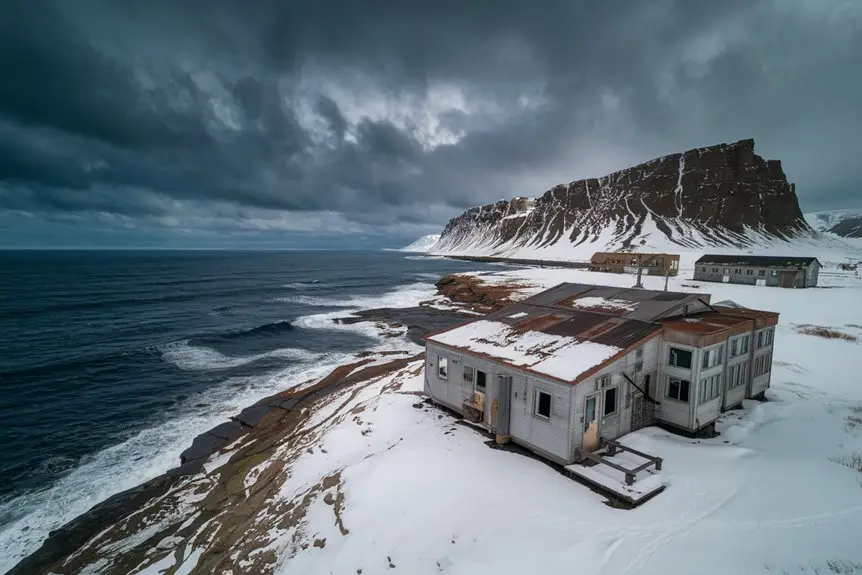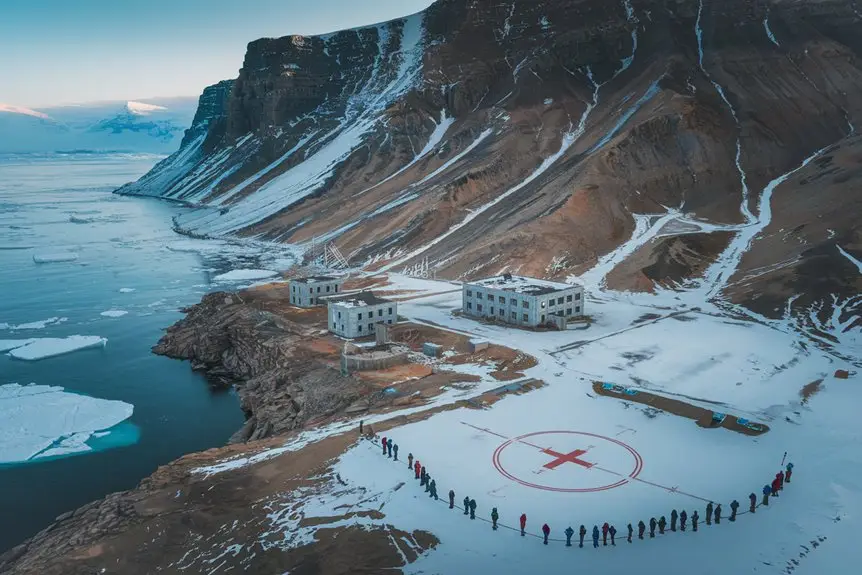You’ll discover a remarkable Arctic destination at Kolyuchin Island, Russia. The island features an old Soviet research station that now serves as a haven for polar bears. You can spot large colonies of puffins and guillemots nesting on the steep cliffs, making it ideal for wildlife photography.
For other Russia Cruise destinations check out our Russia Cruise Ship Ports Guide page.
Summer visits offer the best conditions with temperatures up to 5°C. You’ll benefit from extended daylight hours, giving you more time to observe the local wildlife. You must wear waterproof clothing as the weather changes rapidly in this remote Chukchi Sea location.
Your visit will include guided zodiac trips around the island, where you can watch walruses lounging on the beaches. You must follow your guide’s safety instructions at all times whilst exploring this untamed Arctic environment.
Key points to remember:
- Pack waterproof gear
- Bring your camera
- Listen to your guide
- Stay alert for weather changes
- Watch for polar bears, walruses, and seabirds
🐧 Polar Cruise Enquiry 🐻❄️
Our team of polar travel specialists have personally explored both the Arctic and Antarctic regions – from tracking polar bears in Svalbard to kayaking with penguins off the Antarctic Peninsula. Let us find the right polar expedition cruise for you.
Weather and Landing Conditions

Access to Kolyuchin Island depends on three clear factors: climate, landing sites and sea ice. The subarctic temperatures drop to -20°C in winter but warm to 5°C in summer.
You need to watch the weather closely before your visit. Strong winds and storms can block your landing attempts. The rocky shoreline has uneven ground, which makes walking difficult. Fog often appears suddenly and can stop landing operations.
Summer offers your best landing opportunities because:
- The sea ice reduces
- You get more daylight hours
- The weather is milder
You must stay aware of polar bears and local wildlife throughout your visit, no matter when you choose to travel.
Wildlife Viewing Opportunities

Kolyuchin Island offers excellent wildlife watching opportunities. Male polar bears patrol the island’s shoreline, whilst mother bears and cubs stay near the coast.
The steep cliffs house colonies of puffins, guillemots and kittiwakes, perfect for bird photography.
You’ll spot walruses resting on the beaches during the summer months when the ice melts. To get the best views, take a guided zodiac trip around the island with your binoculars.
Late summer visits might reward you with brown bear sightings, and the Kolyuchin Inlet sometimes hosts bowhead whales.
You can choose between kayaking trips for close-up wildlife views or use a drone for aerial photography without disturbing the animals.
Research Station Exploration

The Western Research Station stands as a fascinating piece of Arctic history that you can spot from your ship. Soviet scientists ran this polar facility from 1943 until February 1992, with a small team of 3-4 researchers manning it during its final years. The last station director set up amateur radio operations using the callsign АС65.
You’ll need to view the station from a distance, as polar bears now call these buildings home. The structures offer them perfect shelter in the harsh Arctic climate.
Your cruise ship’s crew will guide you to safe viewing spots where you can watch both the historic buildings and their current furry residents.
Your safety comes first, so you must follow all crew instructions when observing the station. This unique site shows you how nature reclaims human structures, creating an unexpected wildlife haven from what was once a busy research facility.
Northern Sea Route Significance

The Northern Sea Route offers you a shorter path across the Arctic waters. You can reduce your travel distance by 37% compared to southern shipping routes.
Russia manages the route’s infrastructure and operates icebreaker ships to help vessels navigate the Arctic waters.
You’ll face common challenges like ice-packed seas, extreme cold and thick fog when travelling this route.
Climate change has made the Northern Sea Route more accessible throughout the year. You can now witness how this route connects Asian and European markets through Arctic waters.
The pathway continues to influence trade relationships between Russia and other nations, making it a key route for global shipping.
See what’s on offer from the Uelen Cruise Ship Ports Guide for a different Russia Cruise destination.
Safety and Preparation Tips

Before Your Trip:
- Get medical clearance from your doctor if you have health conditions.
- Book mandatory medical insurance.
- Sign up for pre-trip safety briefings.
- Notify organisers about medical needs.
- Pack essential medications.
What to Pack:
- Waterproof clothing.
- Insulated boots with grooved soles.
- Life jackets.
- Warm gloves.
- Protective hats.
- UV-blocking sunglasses.
During Your Journey:
- Stay close to your guide during shore visits.
- Follow wildlife viewing rules.
- Keep to AECO safety protocols.
- Maintain personal hygiene standards.
Safety Guidelines:
- Watch your step on icy surfaces.
- Keep a safe distance from Arctic wildlife.
- Listen to crew instructions.
- Stay within marked paths.
- Report any health concerns immediately.
Remember: Arctic conditions can change quickly. Your preparation directly affects your safety and comfort throughout the journey. Keep these guidelines handy and refer to them often during your expedition.
Frequently Asked Questions
What Languages Do the Expedition Guides Speak During Tours?
Expedition guides communicate primarily in English and Russian during tours. You’ll find that all guides are fluent in these two core languages. Some guides also speak French, German, Spanish or Italian. Your guide will adapt their language to match your group’s needs, ensuring clear communication throughout your tour.
Are There Gift Shops or Souvenir Purchasing Opportunities on Kolyuchin Island?
Kolyuchin Island has no gift shops or souvenir stores. You cannot buy any items on the island as it remains completely uninhabited. You’ll find shopping opportunities at other stops along your cruise route instead.
What Photography Equipment Restrictions Apply When Visiting the Research Station?
You can bring your camera equipment without specific restrictions. Basic rules apply:
- Keep a safe distance from wildlife
- Do not use flash photography near animals
- No drone photography allowed
- Avoid any disruptive photographic activities
Use your equipment responsibly whilst maintaining the research station’s peaceful environment and respecting wildlife habitats.
Can Passengers Collect Rocks or Artifacts From the Abandoned Research Station?
You must not remove any rocks or artifacts from the research station. The site operates under strict Russian legal protection and requires specific permits for any collection activities.
The area’s environmental sensitivity means you need to follow a ‘leave no trace’ approach during your visit. Simply enjoy observing and photographing the site whilst leaving all items exactly where you find them.
Thinking about something different? Check out the cruises leaving from Wrangel Island Cruise Ship Ports Guide.
🐧 Polar Cruise Enquiry 🐻❄️
Our team of polar travel specialists have personally explored both the Arctic and Antarctic regions – from tracking polar bears in Svalbard to kayaking with penguins off the Antarctic Peninsula. Let us find the right polar expedition cruise for you.
